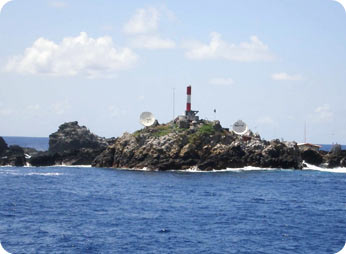The world’s longest mountain range is almost completely hidden from sight. It snakes 10,000 miles along the bottom of the Atlantic Ocean, and peeks into view in only a few places.
 Brazilian Navy scientific station and lighthouse of the Saint Peter and Saint Paul Archipelago. Credit: Wikipedia/John Vergari
Brazilian Navy scientific station and lighthouse of the Saint Peter and Saint Paul Archipelago. Credit: Wikipedia/John VergariOne of those is a tiny group of islands known as Saint Peter and Saint Paul’s Archipelago. It’s near the equator, about 600 miles off the coast of Brazil. It consists of about half a dozen islands plus a few small clumps of rock. The entire group has just four acres of land area.
A Portuguese explorer discovered the archipelago in 1511 when his ship ran aground there.
Charles Darwin visited in 1832. He found no vegetation, but abundant colonies of birds, crabs, and spiders. And the young naturalist noted that the rocks were unlike those of other islands.
Today, we know that’s because they’re part of the Mid-Atlantic Ridge -- a mountain chain that runs down the center of the Atlantic Ocean. It’s where two plates of Earth’s crust are spreading apart, forming new crust. Saint Peter and Saint Paul’s is at the peak of a mountain that’s about 13,000 feet high.
The islands themselves support the same type of life that Darwin saw. The shallow waters around them host coral reefs and fish, including several species that aren’t found anywhere else on Earth. Some species are disappearing from the region, though: sharks. They’re caught to satisfy the global demand for shark-fin soup. Over-fishing has decimated the local populations, adding to the bleak aura of this desolate mountain peak.

